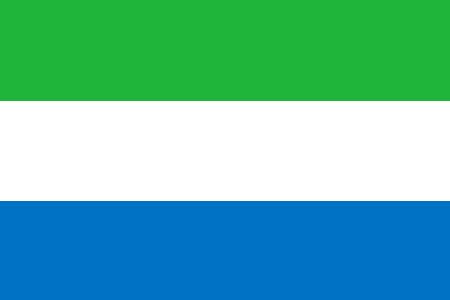0–14 years 41.9% Population 6.092 million (2013) GNI per capita 1,690 PPP dollars (2013) Official languages English, Bengali | 15–64 years 54.4% Life expectancy 45.33 years (2012) Population growth rate 1.9% annual change (2013) | |
 | ||
Density 80.06 inhabitants per sq km. Birth rate 37.40 births/1,000 inhabitants Death rate 11.03 deaths/1,000 inhabitants Infant mortality rate 73.29 deaths/1,000 births Fertility rate 4.78 births per woman (2012) | ||
The demographics of Sierra Leone are made up of an indigenous population from 18 ethnic groups. The Temne in the north and the Mende in the South are the largest. About 60,000 are Krio, the descendants of freed slaves who returned to Sierra Leone from Great Britain, North America and slave ships captured on the high seas. In addition, about 5,000 Lebanese, 1000 Indians, and 5,000 Europeans reside in the country.
Contents
- Map of Republic of Sierra Leone
- Population
- Vital statistics
- Fertility and Births
- CIA World Factbook demographic statistics
- Population growth rate
- Birth rate
- Death rate
- Net migration rate
- Sex ratio
- Maternal Mortality Ratio
- Life expectancy at birth
- Total fertility rate
- Health expenditures
- Physicians density
- Hospital bed density
- HIVAIDS
- Major infectious diseases
- Nationality
- Ethnic groups
- Religions
- Languages
- Education expenditure
- Literacy
- References
Map of Republic of Sierra Leone
In the past, some Sierra Leoneans were noted for their educational achievements, trading activity, entrepreneurial skills, and arts and crafts work, particularly woodcarving. Many are part of larger ethnic networks extending into several countries, which link West African states in the area. Their level of education and infrastructure have declined sharply over the last 30 years.
Population
According to the 2010 revision of the World Population Prospects the total population was 5 868 000 in 2010, compared to only 1 895 000 in 1950. The proportion of children below the age of 15 in 2010 was 43%, 55.1% was between 15 and 65 years of age, while 1.9% was 65 years or older .
Vital statistics
Registration of vital events is in Sierra Leone not complete. The Population Departement of the United Nations prepared the following estimates.
Fertility and Births
Total Fertility Rate (TFR) (Wanted Fertility Rate) and Crude Birth Rate (CBR):
Fertility data as of 2013 (DHS Program):
CIA World Factbook demographic statistics
The following demographic statistics are from the CIA World Factbook, unless otherwise indicated.
Population growth rate
2.33% growth rate (2014 est.)Birth rate
38.12 births/1,000 population (2012 est.)Death rate
11.49 deaths/1,000 population (2012 est.)Net migration rate
-3.86 migrants/1,000 population (2012 est.)Refugees currently in surrounding countries are slowly returning.
Sex ratio
at birth: 1.03 male(s)/femaleunder 15 years: 0.99 male(s)/female15–64 years: 0.92 male(s)/female65 years and over: 0.78 male(s)/femaletotal population: 0.94 male(s)/female (2011 est.)at birth: 1.03 male(s)/femaleunder 15 years: 0.96 male(s)/female15–64 years: 0.92 male(s)/female65 years and over: 1 male(s)/femaletotal population: 0.94 male(s)/female (2000 est.)at birth: 1.03 male(s)/femaleunder 15 years: 0.96 male(s)/female15–64 years: 0.91 male(s)/female65 years and over: 0.9 male(s)/femaletotal population: 0.93 male(s)/female (2005 est.)at birth: 1.03 male(s)/femaleunder 15 years: 0.96 male(s)/female15–64 years: 0.91 male(s)/female65 years and over: 0.94 male(s)/femaletotal population: 0.93 male(s)/female (2003 est.)Maternal Mortality Ratio
890 deaths/100 000 births (2010)Sierra Leone's MMR is the worst of any country in the world, according to the 2000 WHO, UNICEF and UNFPA report.
Life expectancy at birth
total population: 56.55 yearsmale: 54.08 yearsfemale: 59.11 years (2012 est.)total population: 42.84 yearsmale: 40.33 yearsfemale: 45.42 years (2003 est.)total population: 45.25 yearsmale: 42.37 yearsfemale: 48.21 years (2000 est.)Total fertility rate
4.9 children born/woman (2012 est.)Health expenditures
13.1% of GDP (2009)Physicians density
0.016 physicians/1,000 population (2008)Hospital bed density
0.4 beds/1,000 population (2008)HIV/AIDS
adult prevalence rate: 1.6% (2009 est.)people living with HIV/AIDS: 49,000 (2009 est.)deaths: 2,800 (2008 est.)Major infectious diseases
degree of risk: very highfood or waterborne diseases: bacterial and protozoal diarrhea, hepatitis A and typhoid fevervectorborne diseases: malaria and yellow feverwater contact disease: schistosomiasisaerosolized dist or soil contact disease: Lassa fever (2009)Nationality
noun: Sierra Leonean(s)adjective: Sierra LeoneanEthnic groups
20 native African tribes 90% (Temne 30%, Mende 30%, other 30%)Creole 10% (descendants of freed Jamaican slaves who were settled in the Freetown area in the late-18th century)Refugees from Liberia's recent civil warSmall numbers of Europeans, Lebanese, Pakistanis, and IndiansReligions
Islam 60%Christian 10%Indigenous beliefs 30%Languages
English (official, regular use limited to literate minority)Mende (principal vernacular in the south)Temne (principal vernacular in the north)Krio (English-based Creole, spoken by the descendants of freed American and West Indian slaves and Liberated Africans who were settled in the Freetown area, a lingua franca and a first language for 10% of the population but understood by 95%)Education expenditure
4.3% of GDP (2009)Literacy
Definition: Age 15 and over can read and write English, Mende, Temne, or Arabic
Total population: 35.1%Male: 46.9%Female: 24.4% (2004 est.)Total population: 31.4%Male: 45.4%Female: 18.2% (1995 est.)